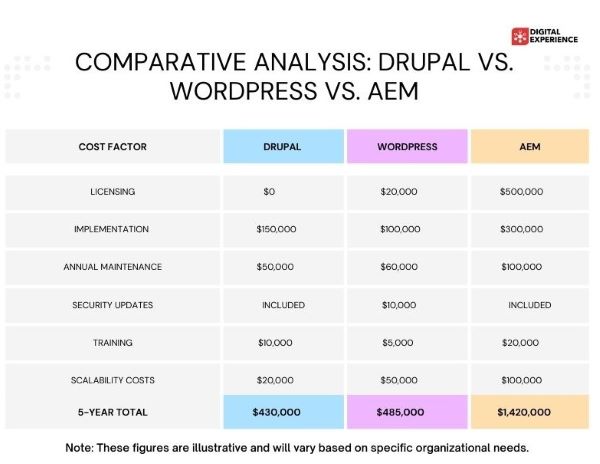Total Cost of Ownership: Drupal vs. Other CMS Platforms - A Comprehensive Analysis

Selecting the right Content Management System (CMS) for your organization is a critical decision that impacts not just your digital presence, but also your bottom line. In this analysis, we'll dive deep into the Total Cost of Ownership (TCO) of Drupal compared to WordPress and Adobe Experience Manager (AEM).
We'll examine both business and technical perspectives to provide a clear, actionable comparison that demonstrates why Drupal often emerges as the most cost-effective and powerful solution for enterprises.
Business Perspective: Understanding the Financial Implications
When evaluating TCO, businesses must consider various cost factors beyond the initial implementation:
a) Licensing Costs:
| Drupal | Open-source, no licensing fees |
| WordPress | Core is open-source, but many enterprise features require premium plugins with ongoing licensing costs |
| AEM | Significant licensing fees based on traffic or CPU cores |
b) Implementation Costs:
| Drupal | Moderate to high, depending on complexity |
| WordPress | Generally lower for basic sites, but can increase significantly for enterprise needs |
| AEM | High, often requiring specialized developer |
c) Maintenance and Support:
| Drupal | Community support is free; enterprise support available through partners |
| WordPress | Community support for core; plugin support varies |
| AEM | Requires ongoing paid support from Adobe or certified partners |
d) Scalability Costs:
| Drupal | Scales efficiently with minimal additional costs |
| WordPress | Can become costly as you scale due to increasing plugin and hosting needs |
| AEM | Scales well but at a high cost due to licensing structure |
Actionable Insight: Conduct a 5-year TCO projection for your specific use case, factoring in expected growth and feature needs. This often reveals Drupal's long-term cost advantages.
2. Technical Perspective: Evaluating Platform Capabilities
From a technical standpoint, TCO is heavily influenced by the platform's capabilities and efficiency:
a) Development Efficiency:
| Drupal | Highly modular, with a steep initial learning curve but high efficiency for complex projects |
| WordPress | Easy to use for simple sites, but can become unwieldy for complex enterprise needs |
| AEM | Powerful but complex, requiring specialized skills |
b) Security:
| Drupal | Strong security team and processes, reducing long-term security maintenance costs |
| WordPress | Frequent updates required, especially for plugins, increasing maintenance overhead |
| AEM | Robust security, but updates can be complex and costly |
c) Performance Optimization:
| Drupal | Built-in caching and optimization features reduce the need for additional performance tools |
| WordPress | Often requires additional caching plugins and optimization efforts |
| AEM | Offers good performance but may require significant tuning |
d) Integrations and Extensibility:
| Drupal | Highly extensible with a vast ecosystem of modules |
| WordPress | Large plugin ecosystem, but quality and security can vary |
| AEM | Powerful integration capabilities, but often at a higher cost |
Actionable Insight: Map out your technical requirements and evaluate how each platform meets them out-of-the-box vs. requiring additional development or third-party solutions.
Comparative Analysis: Drupal vs. WordPress vs. AEM
Let's break down the TCO for a hypothetical large enterprise over a 5-year period:

Why Drupal is the Most Cost-Effective CMS Platform
- Long-term Cost Efficiency: Drupal's open-source nature and scalability result in lower TCO over time, especially for complex, large-scale implementations.
- Flexibility and Customization: Drupal's modular architecture allows for precise tailoring to business needs without incurring excessive costs.
- Enterprise-Grade Security: Drupal's security team and processes reduce the risk of costly breaches and minimize security-related maintenance expenses.
- Scalability Without Compromise: Drupal handles growth efficiently, avoiding the ballooning costs often associated with scaling WordPress or the high licensing fees of AEM.
- Community and Innovation: The vast Drupal community continually contributes improvements and innovations, providing value without additional cost.
- Content Modeling and Structure: Drupal excels in handling complex content structures and relationships, crucial for large organizations with diverse content needs.
- Multisite and Multilingual Capabilities: Built-in features for managing multiple sites and languages reduce the need for costly add-ons or complex workarounds.
Drupal- Your preferred Choice
While the initial investment in Drupal may be higher than some alternatives, its TCO over time often proves to be significantly lower, especially for large enterprises with complex needs. Drupal's combination of flexibility, scalability, and robust feature set makes it the most cost-effective choice for organizations looking to build a powerful, long-lasting digital platform.
By choosing Drupal, enterprises not only save on long-term costs but also gain a future-proof platform capable of evolving with their needs. The initial learning curve and investment pay dividends through reduced ongoing expenses, enhanced security, and the ability to rapidly adapt to changing business requirements without incurring significant additional costs.




